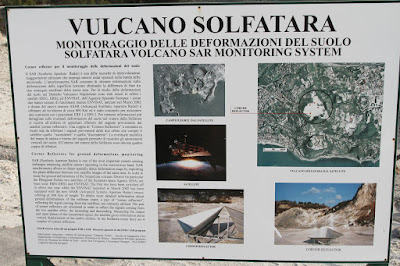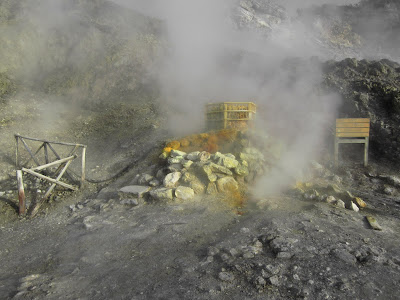
Visiting Solfatara was very refreshing. Why? Because we had just come from the Parco Archeologico di Cuma and were a little bewildered, plus, we had a harrowing 20 minute ride over a road in the Monte di Procida area (thank you Tom Tom – or as we called it during the trip: Dumb Dumb) looking for a restaurant and failing. We needed something simple and easy and Solfatara was the ticket.
Pulling into Solfatara (and you do go through a building to get into it) was relaxing and relatively uncomplicated.
Solfatara is a volcano crater located near Pozzuoli in the caldera called the Campi Flegrei (Phelgraean Fields, meaning burning fields). Most of the Campi Flegrei lies underwater in the Golfo di Pozzuoli. The satellite view of the Campi Flegrei by NASA gives the best idea of the extent of the caldera. Also in the caldera is the city of Pozzuoli.
In ancient times it was the Roman colony named Puteoli from the Latin putere (to stink). In Italian, to stink is puzzare. To muddy the linguistic waters, pozzalana, is a type of fine, sandy volcanic ash. We don’t know what names derived from what words or vice versa, but the connections are there.
Solfatara (from the Latin Sulpha terra – sulfur earth) last erupted in 1198 and today is considered dormant. Though, walking around the crater with its bubbling mud pools and steaming fumaroles, it seems very much alive. The Bocca Grande (big mouth) is the largest fumarole in the Solfatara. Steam exits at 160° C and contains salts such as realgar (As4S4), cinnabar (HgS) and orpiment (AS2 S3) which give the reddish-yellow color to the rocks. Of course, it’s the hydrogen sulphide (H2S) which gives the characteristic smell of rotten eggs that you'll notice the most.
The Bocca Grande is said to be the inspiration for the entrance to hell in Dante’s Inferno. Besides just serving to inspire, the crater has been used as a spa because the waters were considered effective for treating nervous diseases, problems of sight, fevers and more. The water was prized for its “bitter lemony flavour”. Can’t say we tried it.
A sign in the crater cites a recent article (2009) touting the fact that weddings never decrease in Pozzuoli and the number of births exceed 1000 per year, well okay. Furthermore, the article continues, hydrogen sulfide (H2S) is key in the vasodilation process of erection and this is the very same gas in the steaming fumaroles of Solfatara. Hence, Pozzuoli has been blessed with “happy sex” likely due to the inhalation of the gas more so than their poor fellow countrymen who don’t live near a sulphur-spewing crater. I guess we breathed enough that we'll check later this evening for the happy sex part.
Solfatara History Sign

Crater Floor

Mud Pool

Monitoring Solfatara

La Bocca Grande

Happy Sex Sign

Fumaroles - Looking West

Remains of Structure Once Used for Collecting Steam to Produce Alum?
Solfatara History Sign

Crater Floor

Mud Pool

Monitoring Solfatara

La Bocca Grande

Happy Sex Sign

Fumaroles - Looking West

Remains of Structure Once Used for Collecting Steam to Produce Alum?

No comments:
Post a Comment
All comments are moderated. If your comment doesn't appear right away, it was likely accepted. Check back in a day if you asked a question.